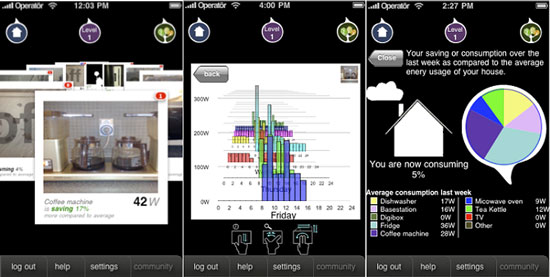| Mar 22, 2013 |
When energy-saving becomes a game
|
|
(Nanowerk News) A smartphone application bringing gaming dimensions to energy awareness has helped householders in Finland, Sweden and Italy reduce their electricity consumption by up to 19%.
|
|
Householders do not always know how much energy they consume. To help improve their awareness, the EnergyLife app was developed through BeAware, a EU funded project, led by the Helsinki Institute for Information Technology (HIIT), in Finland. As part of the project, consumers in test groups had their home appliances fitted with wireless sensors. This enabledreal-time information on power consumption to be delivered via the mobile app. What makes this app unique? It is designed like a game to entice consumer to treat energy saving as a fun activity. By reading tips, completing quizzes and reducing their electricity usage they were able to collect scores and progress through higher levels in the game.
|
 |
| EnergyLife app
|
|
“What we noticed with all lot of energy awareness programmes is that they have an impact for a limited time, but people lose interest over time,” explains Giulio Jacucci, the project coordinator and a professor of computer science at HIIT. “The idea of gamification is to maintain engagement by accompanying the consumer through a process whereby they learn something, achieve some goals and move on to the next level. If they are under-challenged, they will become bored whereas if they are over-challenged, they become frustrated.” He believes the game provides a way of always keeping consumers engaged with the right amount of challenge.
|
|
This approach leads to collaboration among players. “The gamification process introduces some interesting social mechanisms,” he adds, “The users compete one against another initially. But after a while, they start to ask questions of each other, so it becomes cooperative in the way they share new information and knowledge.” Jacucci says that he intuitively believes the gaming aspects enhance the effectiveness of the app. However, because the study did not include a control group receiving the same advice through more conventional means, he acknowledges results are inconclusive.
|
|
What the results nevertheless showed that when users were provided with personalised feedback, they achieved the greatest savings. This, Jacucci believes, is because it crystallised the link between specific behaviour – for example putting something very hot in the refrigerator – and experiencing a temporary set-back in meeting goals, as part of the game. “Personalising the advice can really make a difference,” agrees Niamh McDonald, a buildings policy analyst at the Global Buildings Performance Network in Paris, France. She tells youris.com: “Not everyone is the same, and different households will have different needs, values and interests.”
|
|
She also argues that because the user experience is designed to be positive,programmes like EnergyLife offer greater chances of success than campaigns setting out to make consumers feel guilty about damaging the environment. “If people take the time to get involved in a voluntary programme, it makes no sense to criticise them,” she says. “Rather than preaching, empowering them to make changes is definitely the way to go.”
|
|
Many behavioural change programmes fail because it takes time to achieve real results, according to Alec Dorling, manager of embedded software process organisation with theVolvo Group in Sweden. Referring to his own research on the role of gamification in software process improvement, he tells youris.com: “In game playing, the psychology is to provide a lot of points early on, enabling achievement of levels 1-2 very quickly. This provides fast feedback and creates engagement and motivation.” The key to making energy saving “fun”, Dorling believes, centres on carefully maintaining the balance between abilities and challenge.
|

